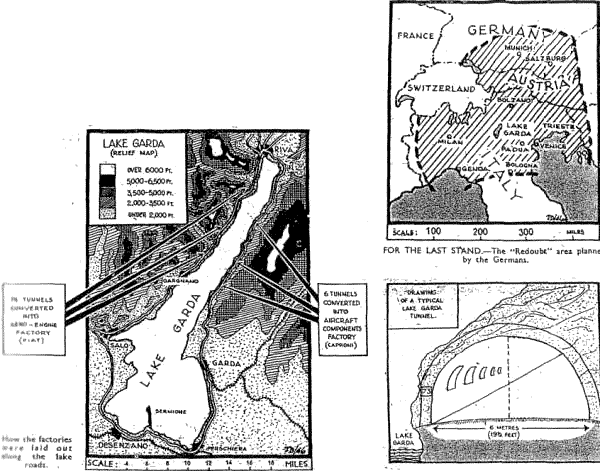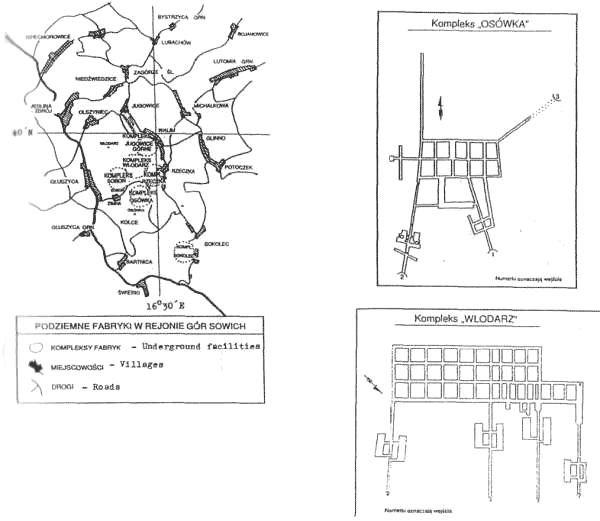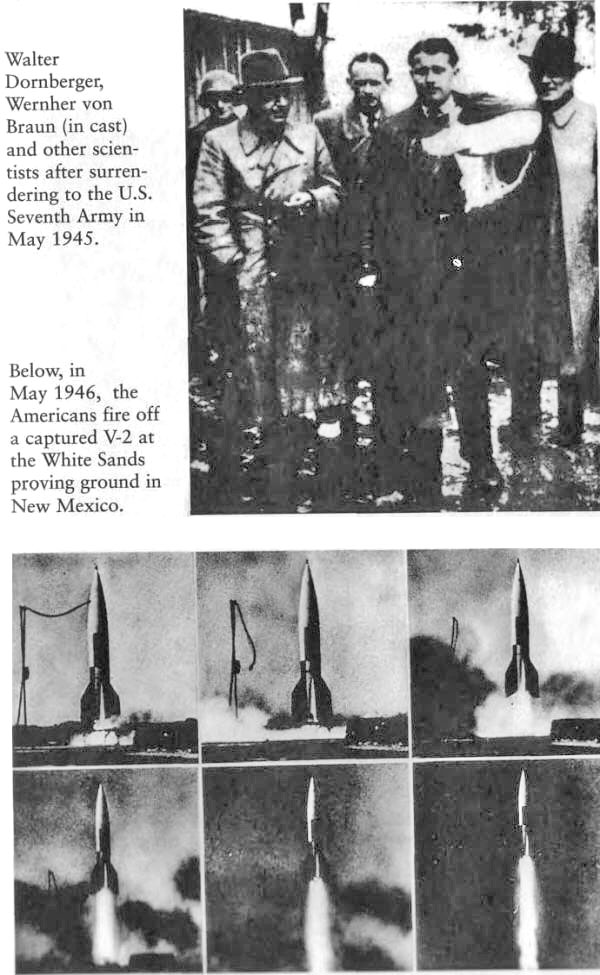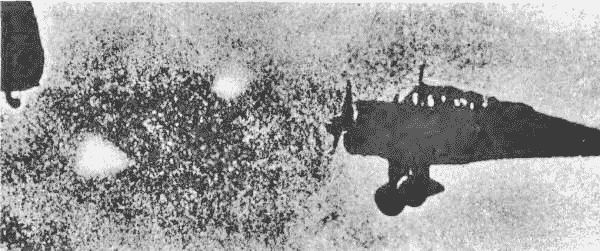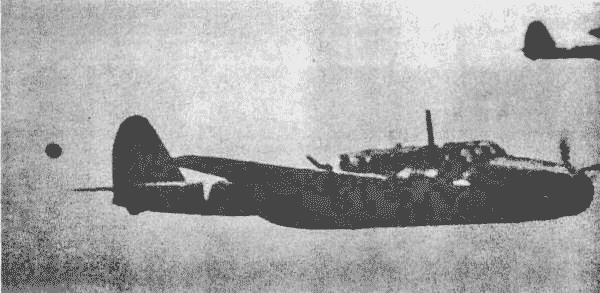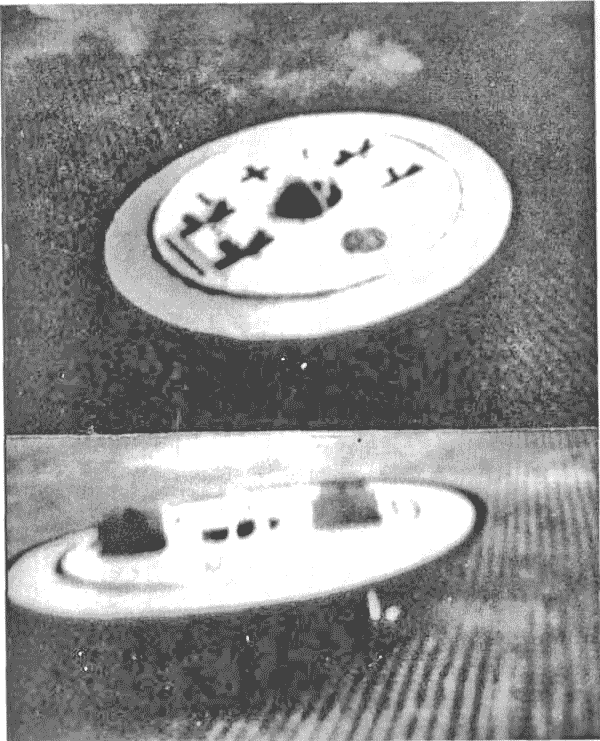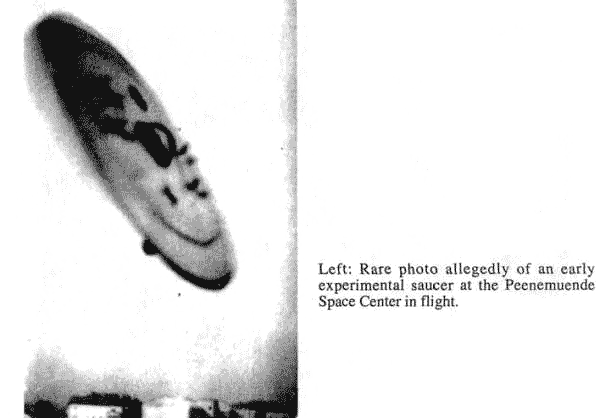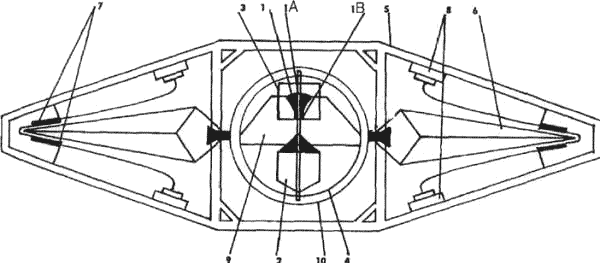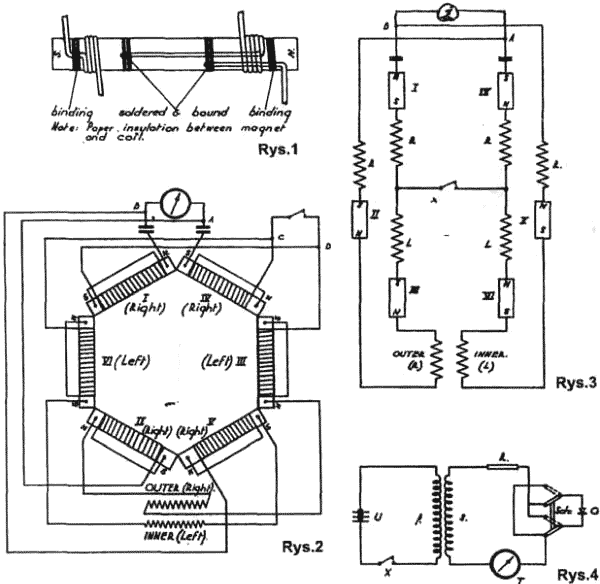|
CHAPTER ONE: THE SITUATION WITHIN NAZI GERMANYThanks to the American media and what passes for history, most Americans have no idea of wartime conditions within Germany. The topics most germane to this discussion are the means of wartime industrial production and transportation within Germany. After the Battle of Britain, Germany's air domination over Europe began to decline, sliding down a slippery slope which ultimately resulted in one major reason for its defeat. German means of industrial, arms, and energy production became increasing venerable to attack by Allied bombers. The munitions plants needed to produce the arms to maintain the war effort, such as tanks, airplanes and cannons were all targets of Allied air bombardment. Likewise, high priority targets included oil production and refining facilities which produced the fuel and lubricants needed to make the war effort possible. One way Germany responded to air attacks was by moving munitions facilities and high-value industrial plants underground (1).Some of these facilities were vast, encompassing miles of underground tunnels. They housed both the industrial means of war production and the workers themselves. The facilities at Nordhausen in Thuringia are well known as the site of production for the V-l and V-2, but there were others. The newly discovered underground complexes of the Jonas Valley south of Nordhausen in Thuringia constitute another vast complex (2)(3). This facility was to serve as a center of government and most probably a research center for advanced weaponry. This is also true for the many underground complexes in what is now Poland. Notable among these is a facility called "Der Riese" (The Giant). Der Riese served as a uranium mine, uranium processing facility, and research and development facility for secret weapons (4). Underground facilities for weapons production were found throughout Germany, Austria, Czechoslovakia and Poland. Underground production facilities were also set up to refine synthetic petroleum products from coal and to generate electricity. In addition to underground facilities, camouflage was used to hide numerous smaller facilities. These many camouflaged and underground plants formed a web of sub-assembly producers. Each sub-assembly facility sent their product to a larger or a more centrally located facility for further work. From there it might be transported again for final assembly. As an example, type XXI U-boats were modular, being produced in pipe-like sections throughout Germany. They were transported by rail to sites near the North Sea and only finally assembled at water's edge. Likewise, some types of aircraft were only finally assembled near the runway. Further confusing Allied air intelligence, the plants were constantly moving. Eventually everything of value was to be moved underground, to bomb-proof shelters. Facilities were kept on the move until space was available for this underground re-location. These tactics worked for the Germans. There were simply too many moving targets for the Allies to completely stop German war production. Of course the weak link in this scheme was transportation. The railroad system was the only practical and most energy efficient method of moving all these sub-assemblies. Trucking material was done but in a petroleum-starved Third Reich, it was not possible to sustain a truck-based transportation system necessary to meet all the requirements of wartime Germany. Recognizing this, the Allies bombed railroad centers using the heavy, four-engine B-17bombers. By mid-1943 the American P-51 Mustang was introduced into the field of play. This aircraft could be thought of as a Spitfire which could fly for eight hours. Its range allowed it to escort Allied bombers to their targets throughout the Reich. After escorting the bombers to their targets the P-51s were released to attack "targets of opportunity". A P-51 can fly close to the ground and attack individual trains, which they did. Perhaps you will recall the many wartime film clips showing these P-51s destroying German trains as they traveled. By mid-1944, it is a wonder that any trains within Germany could move at all. Some were forced to hide in mountain tunnels, as they did near the Jonas Valley, running at night or when there were no enemy aircraft reported. As a result of these day and night air attacks, Germany found itself increasingly the victim of shortages of material and fuel, limiting its ability to make war. Though Germany's air defense system was the best of any warring nation, it was clear that if Germany was to survive,improvement was imperative. Germany experimented with radically new types of air defense systems. Anti-aircraft rockets, guided both from the ground and by infra-red homing devices were invented. Vortex cannons, sun cannons, air-explosive turbulence bombs, rockets trailing long wire to ensnare enemy propellers,numerous electronic jamming devices, electronic devices designed to stop ignition-based engines, magnetically repulsed projectile sand long-range x-ray "death rays" were all under development as the conflict ended (5) (6). Among these exotic solutions were saucer-shaped interceptor aircraft. The Germans already had jet and rocket interceptors as well as jet and rocket attack vehicles. German skies were full of these and other exotic aircraft so this new saucer shape was not considered as important then as we do today looking back upon it from a UFO perspective. To the German military and civilians alike these were just more new weapons. The "Alpenfestung" From top to bottom, right to left are: The "Alpenfestung"which was the southernmost island of defense planned by the Germans; Diagram of the Fiat underground facility at Lake Garda in Northern Italy which worked under direction of the Germans; A cross section of the tunnel. It was in this facility where Renato Vesco worked during the Second World War. As the conflict drew to its conclusion, military planners in Germany considered the idea of concentrating their ground and air defenses into specific fortresses for a last stand. This would buy them time. They needed time to perfect new "Siegerswaffen",super-weapons so powerful that they could turn the course of the war for Germany by themselves. A mountain fortress or "Alpenfestung" was to be set up in the German held areas of Northern Italy, Austria and Germany in roughly the areas in which these countries converged with each other and Switzerland (7). A fortress was to be set up in the Harz Mountains of Thruingia including several large underground complexes. This would extend from Nordhausen in the north down through Kahla and into the Jonas Valley. Another similar fortress complex was scheduled for the Owl Mountains separating Poland from Czechoslovakia including "Der Riese" mentioned earlier (8). Another fortress was to be set up in the Black Forest of Southern Germany. Other minor islands of resistance were to be set up in Norway, the Bohemian forest and the Bavarian forest (9). These fortifications were to house soldiers, mostly SS units. They would also provide underground hangers and bomb-proof overhangs for aircraft take-offs and landings. Missiles, such as the V-l and V-2, and other weapons were to be mass produced there and fired automatically, right off the automated assembly line.The exotic weaponry mentioned above was to be employed, along with especially trained mountain troops, defending the mountain passes into these fortresses (10). History tells us the Alpenfestung never actually happened. It did not happen because German construction was simply not able to make these places ready in time. What is important for us to realize is that the weaponry for these fortresses was being developed as the Second World War drew to a close. Few of these weapons reached the operational stage but many were in various stages of development. When Hitler took power in 1933 one of his first decisions was to rebuild the German Air Force, the Luftwaffe. This new organization was to make a clean break with the old and this reasoning was reflected in its research and development facilities, the RLM, which were the finest of any branch of the German military. Two brilliant research facilities were also in the possession of the Luftwaffe, the Lilenthalgesellschaft and the Academy of Air Research. Besides the Luftwaffe, there was the Army which did develop such things as the V-l cruise missile.There was the Speer Ministry of Arms which did research. In addition, a system of research and development facilities was setup headed by a research council, the "Reichsforschungrat". Their job was to coordinate the technical schools and universities, the military and governmental research groups, and the research and development facilities into a concerted effort (11). The Underground Complex "Der Riese" "Der Riese", ("The Giant" in English), is located in the"Gory Sowie" or Owl Mountains of modern-day Poland. It consisted of seven underground complexes which concerned themselves with the mining, refining, research and development of uranium both for energy producing machines and weapons of war. The tunnels of the larger complexes are almost two miles in length. Courtesy of Robert Lesniakiewicz. Mr. Lesniakiewicz is a Polish engineer and a member of the research group responsible for opening, exploring and mapping of "Der Riese". Another fact that influences our story was the ascendance of the SS (Schutz Staffel). The SS began simply as Hitler's body guard. From humble beginnings it was transformed into the most powerful entity within the Third Reich after Hitler himself. The military arm of the SS, the Waffen SS, became the most elite military force in Germany. The SS also took over many research,development and production facilities from the Army and Air Force. The SS took over control of civilian research and development facilities. The SS began taking facilities and power away from Albert Speer's Ministry of Arms and the RLM headed by Hermann Goering. As the war progressed, the SS organized, built and ran many underground manufacturing facilities (12). They even appropriated the huge industrial firm, the Skoda Works, its subsidiaries and related firms, centered near Prague, for their in-house projects (13). The SS became an empire within an empire answerable only to Adolf Hitler. The SS also set up special research facilities for politically unreliable scientists. Research projects arose within these facilities which were in part staffed by technical people drawn from the prisoner pool. Such facilities were set up at Oraneinburg, Nordhausen, Mechlenburg and Mathausen (14). As the SS rose within Germany, so did the fortunes of Doctor of Engineering, General Hans Kammler. Kammler seems to come into prominence through his talent at designing and building massive underground facilities (15). Soon Kammler was placed, by Hitler,in charge of V-weapons (Vergeltungswaffen). This means Kammler was in charge of the facilities at Peenemuende and Nordhausen. He was Dr. and General Walhter Dornberger's boss who, in turn was Dr. Wernher von Braun's boss. Further, Kammler headed up an advanced research and development group, associated with the Skoda Works, called the Kammler Group (16). This group held the most advanced technical secrets of the Third Reich. During post-war questioning, when asked for details concerning V-weaponry, Albert Speer told Allied interrogators to ask Kammler these questions (17). They never did, however, because the 42 year old General Kammler had disappeared. Kammler was no fool. Wherever he went he undoubtedly took copies of the most advanced German technology. Numerous countries would have dealt with Kammler, regardless of his past. This includes the U.S.A.Couple this with the fact that no search was ever made for General Kammler in spite of the fact that he extensively employed slave-labor in his projects. Did Kammler do a secret deal with an Allied government,exchanging information for a new identity? Or did Kammler escape Allied clutches to some safe haven such as South America? It is known that the Nazis set up shop in large, secure tracts of land between Chile and Argentina. It is also known that UFOs were seen earlier in that region than in the USA after the war. Many post-war stories involve German scientists relocating in South American countries formerly friendly to the Nazis and there building and flying German saucers. CHAPTER ONE The Situation Within Nazi Germany Sources and References
Some of the earliest forms of UFOs, reported during the 1940s, were the ball of light phenomena known as 'foo fighters,' as depicted here. Above: Few photos of foo fighters are currently known. The top photo is one of the most famous, taken over Europe; the bottom was taken over the Sea of Japan between Japan and Korea in 1943. Above: Rare photos allegedly of an early experimental saucer at the Peenemuende Space Center.Above: Internal plans for a "Vril-1" saucer, according to Polish historian Igor Witkowski. Patent for the Coler Converter, a free energy device designed by Hans Coler in 1937. 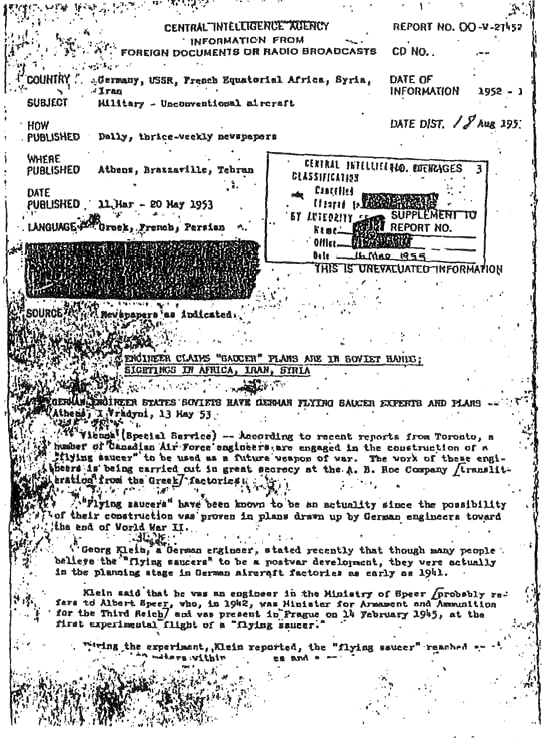
A C.I.A. document dated August 18, 1952 mentioning that the Germans were building "flying saucers" as early as 1941. From the German book Die Dunkle Seite Des Mondes (The Dark Side of theMoon) by Brad Harris (1996, Pandora Books, Germany). Index |
